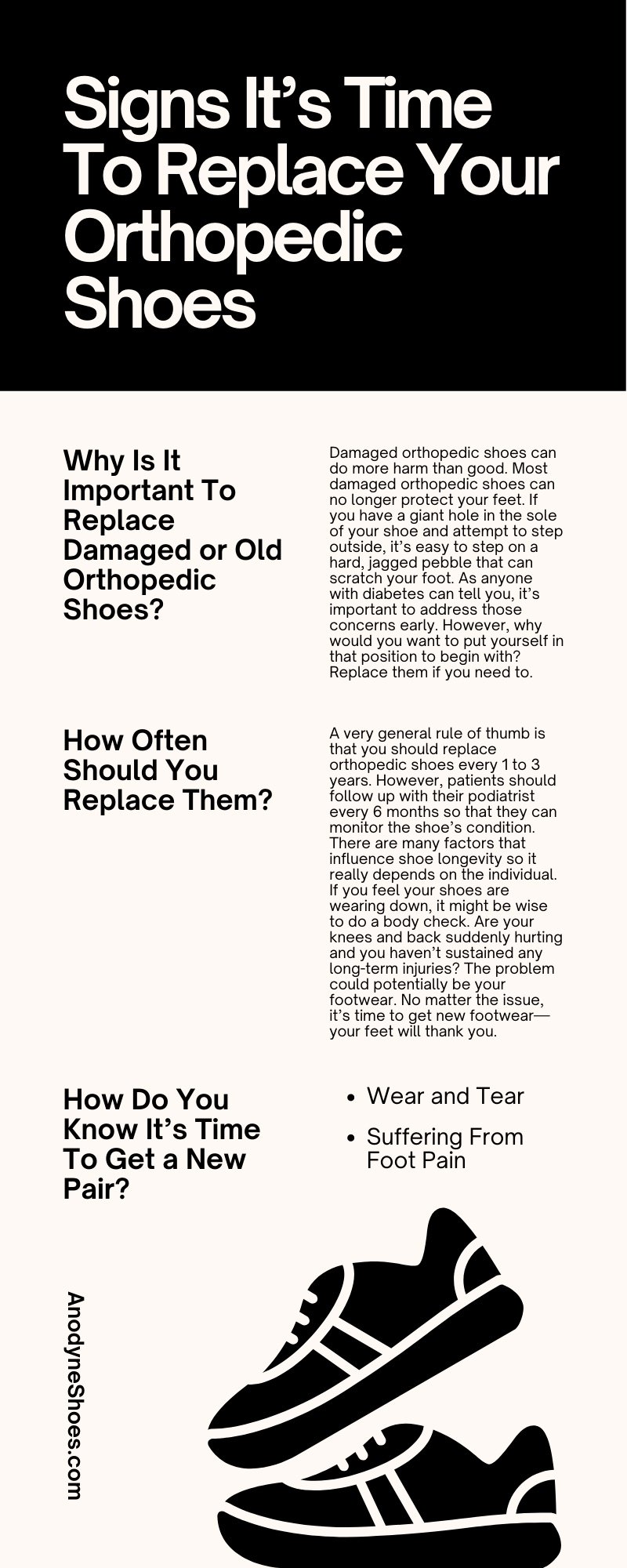%20(750%20x%20422%20px)%20(3).jpg?width=623&height=351&name=Anodyne%20Blog%20Template%20(1080%20x%201080%20px)%20(750%20x%20422%20px)%20(3).jpg)
If you’ve been diagnosed with diabetes, you likely have much on your plate. One of the first things your doctor—especially your podiatrist—likely mentioned is the necessity of new shoes. They probably also mentioned that you shouldn’t just get a standard pair. People with diabetes tend to wound easily and struggle with circulation issues, corns, callouses, and bunions. So, what do you do?
Orthopedic shoes help with all those things, so getting a good pair is essential to foot health for a person with diabetes. However, if you have had them for a while, it might be time for a replacement. What are some of the signs it’s time to replace your orthopedic shoes, and around what time should you look for another pair? Read on to find out when you need to replace your orthopedic shoes.
Why Is It Important To Replace Damaged or Old Orthopedic Shoes?
Damaged orthopedic shoes can do more harm than good. Most damaged orthopedic shoes can no longer protect your feet. If you have a giant hole in the sole of your shoe and attempt to step outside, it’s easy to step on a hard, jagged pebble that can scratch your foot. As anyone with diabetes can tell you, it’s important to address those concerns early. However, why would you want to put yourself in that position to begin with? Replace them if you need to.
Alternatively, your orthopedic shoes could need to be replaced due to age. They could have worn tread patterns, tears on the side that keep them from protecting your feet, or any other issues. The same rules apply. Worn and aged shoes have compromised protective capacities, making them more and more useless the longer you have them. If you’ve damaged them or noticed signs of aging, it’s time to get a replacement.
How Often Should You Replace Them?
A very general rule of thumb is that you should replace orthopedic shoes every 1 to 3 years. However, patients should follow up with their podiatrist every 6 months so that they can monitor the shoe’s condition. There are many factors that influence shoe longevity so it really depends on the individual. If you feel your shoes are wearing down, it might be wise to do a body check. Are your knees and back suddenly hurting and you haven’t sustained any long-term injuries? The problem could potentially be your footwear. No matter the issue, it’s time to get new footwear—your feet will thank you.
How Do You Know It’s Time To Get a New Pair?
So, we’ve talked about what orthopedic footwear is, why it’s important to replace them, and how often you should replace them. Now, we’ll discuss signs that it’s time to get a new pair of orthopedic shoes. Read on below for details.
Wear and Tear
Women’s and men’s therapeutic shoes certainly take a beating. If you think about it, they take the scuffs and scratches your bare feet would take if they didn’t have a barrier to protect them. Now imagine what years of those scuffs and scratches would do to your bare feet if you had to deal with the ground. Though they’re built to last, the friction, constant movement, and pressure will eventually take a toll on the shoe.
Exposure to wear and tear can’t be avoided, but if the problem is too bad, it might be time to get a replacement. A good way to determine if your shoes are starting to succumb to wear and tear is to check the sole of each shoe to see if the traction has decreased.
Suffering From Foot Pain
If you’re suffering from foot pain, you likely don’t have proper arch support. Plantar fasciitis, shin splints, and fractures are common issues. Furthermore, if you have issues with diabetic neuropathy, you can expect the neuropathy to worsen significantly with worn shoes. This means you need to be aware of shooting pains numbness, and tingling in your legs, which all may result from unnecessary pressure on the foot and ankle.
As a person with diabetes, this is the last thing you want to happen as it can cause pain and permanent nerve damage in the long run. If you find yourself dealing with this problem more frequently, see your podiatrist so they can examine your feet.
Tread Pattern
Make sure you assess the appearance of your shoes to determine whether they’re ready to be replaced. What’s the first sign of a shoe that’s on its last leg (pun intended)? The shoe treads—the part that comes in constant contact with the ground—will be smooth rather than threaded. This means that the shoe’s shock absorption isn’t where it should be, and your feet ultimately won’t be as supported, which could lead to those painful symptoms we discussed earlier. This is a key sign that it’s time to replace your orthopedic shoes.
Size and Fit
Did you know that feet constantly change in size? Their shape, height, and width always change, so getting them properly fitted by the podiatrist or replaced is important. If your shoes fit tighter than usual, that’s usually why. However, your feet could also be swelling, which is something you’ll want to look out for as well. If your shoes are ill-fitting, they could be a danger to you, so don’t hesitate to replace them if they make you uncomfortable.
Twist Them
This is a strange way to conclude, but it’s a surefire way to learn whether or not your shoes can still support you. Take your shoes in your hands and twist them. Supportive shoes will be somewhat stiff and offer the support you need. Otherwise, it might be time to trash them and get something new.
Ultimately, knowing when it’s time to let something go is important. Keep orthopedic shoes for the duration you need them, but know when it’s time to let them go—and find a better pair when you do. If you want some of the best diabetic shoes on the market, we have them at Anodyne. Shop Anodyne today!



.png?width=116&name=Anodyne_circle_1_logo%20(2).png)
